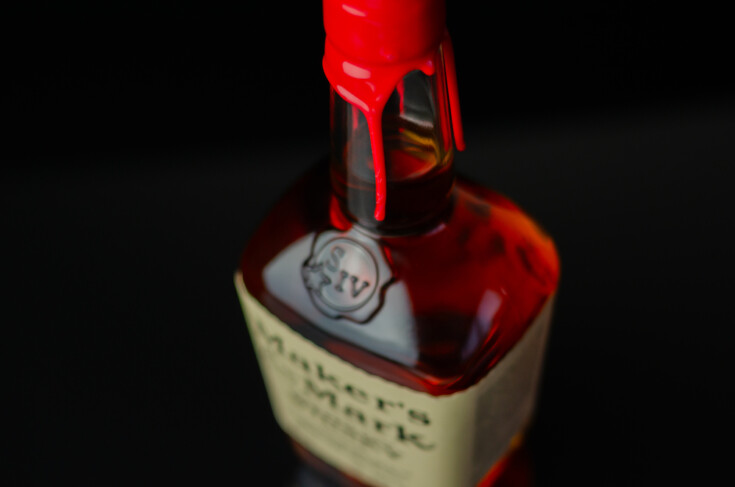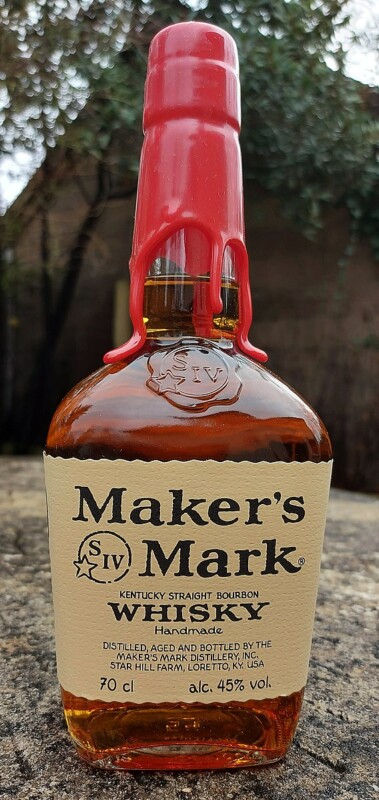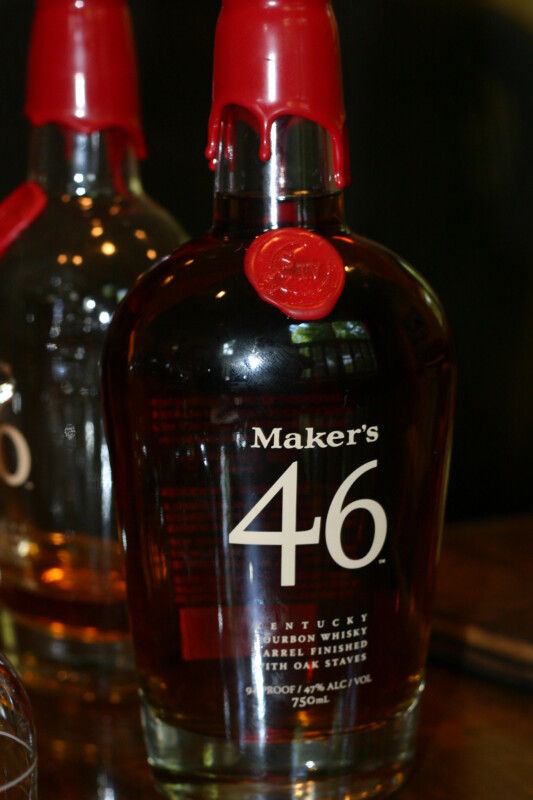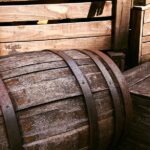
Are you a whiskey lover searching for your next favorite bourbon? Look no further than Maker’s Mark and Maker’s Mark 46. Both bourbons are produced by the same distillery and share many similarities, but there are also key differences between the two. In this article, we will compare Maker’s Mark vs Maker’s Mark 46 and help you determine which one is right for you.
Table of Contents
History of Maker’s Mark and Maker’s Mark 46
Maker’s Mark’s History
 photo credit: commons.wikimedia.org
photo credit: commons.wikimedia.org
Maker’s Mark was founded in 1953 by Bill Samuels Sr. and his wife Margie Samuels in Loretto, Kentucky. The brand is known for its unique red wax seal on the bottle, which was inspired by Margie’s family tradition of dipping bottles in red sealing wax.
Maker’s Mark is a wheated bourbon, which means that wheat is used as the secondary grain in the mash bill, along with corn and malted barley. This gives the bourbon a softer, smoother taste compared to bourbons that use rye as the secondary grain.
The brand’s signature bottle shape, with its square body and long neck, was also designed by Margie Samuels. The label features a handwritten font that was inspired by her own handwriting.
Maker’s Mark 46’s History
 photo credit: www.flickr.com
photo credit: www.flickr.com
Maker’s Mark 46 was introduced in 2010 as a new expression of the original Maker’s Mark. The bourbon is aged slightly differently than the original, with French oak staves added to the barrels during the aging process.
The staves are heavily charred and provide a unique flavor profile to the bourbon. Maker’s Mark 46 is also bottled at a higher proof than the original Maker’s Mark, at 94 proof compared to 90 proof.
The name “Maker’s Mark 46” comes from the fact that it is the 46th recipe that the brand’s master distiller, Kevin Smith, tried before settling on the final product.
Production Process
Maker’s Mark’s Production Process
Maker’s Mark is made using a traditional sour mash process and is distilled in small batches of less than 1,000 gallons. The production process involves the following steps:
- Mash Bill: The mash bill for Maker’s Mark consists of 70% corn, 16% soft red winter wheat, and 14% malted barley.
- Mashing: The grains are cooked with water to create a sweet mash.
- Fermentation: Yeast is added to the sweet mash, and the mixture is allowed to ferment for around three to four days.
- Distillation: The fermented mash is distilled twice in copper pot stills to create a clear spirit.
- Aging: The clear spirit is then aged for around six years in new charred oak barrels, giving it its distinctive flavor and amber color.
- Bottling: After aging, the whiskey is bottled at 90 proof.
Maker’s Mark 46’s Production Process
Maker’s Mark 46 is made using the same sour mash process as Maker’s Mark, but with an additional step before aging. The production process involves the following steps:
- Mash Bill: The mash bill for Maker’s Mark 46 is the same as Maker’s Mark, consisting of 70% corn, 16% soft red winter wheat, and 14% malted barley.
- Mashing: The grains are cooked with water to create a sweet mash.
- Fermentation: Yeast is added to the sweet mash, and the mixture is allowed to ferment for around three to four days.
- Distillation: The fermented mash is distilled twice in copper pot stills to create a clear spirit.
- Stave Insertion: Before aging, 10 seared French oak staves are inserted into the barrel to create additional flavors and aromas.
- Aging: The whiskey is then aged for around six years in new charred oak barrels, giving it its distinctive flavor and amber color.
- Bottling: After aging, the whiskey is bottled at 94 proof.
The production process for Maker’s Mark and Maker’s Mark 46 are quite similar, with the main difference being the stave insertion step for Maker’s Mark 46. This additional step gives Maker’s Mark 46 a more complex and refined flavor profile compared to Maker’s Mark.
Taste Comparison
When it comes to taste, Maker’s Mark and Maker’s Mark 46 have several similarities and differences. Both bourbons have a sweet and smooth taste with a hint of vanilla and caramel. However, Maker’s Mark 46 has a more complex flavor profile due to the added French oak staves during the aging process.
The addition of the French oak staves to Maker’s Mark 46 gives the bourbon a deeper and richer flavor with notes of spice, oak, and fruit. On the other hand, Maker’s Mark has a lighter and more straightforward taste with a focus on the sweet and smooth notes.
In terms of the finish, Maker’s Mark 46 has a longer and more lingering finish due to the added complexity of flavors. Maker’s Mark, on the other hand, has a shorter and cleaner finish with a focus on the sweetness.
If you prefer a more complex and flavorful bourbon, Maker’s Mark 46 is a great choice. However, if you prefer a simpler and sweeter taste, Maker’s Mark is the way to go.
Price Comparison
When it comes to choosing between Maker’s Mark and Maker’s Mark 46, price can be a factor to consider. Here’s a breakdown of the prices for each:
| Whiskey | Price Range (750ml) |
| Maker’s Mark | $30-$32 |
| Maker’s Mark 46 | $40-$45 |
As you can see, Maker’s Mark 46 is generally priced higher than the original Maker’s Mark. However, it’s important to note that the price can vary depending on where you purchase it from.
When considering which whiskey to purchase, it’s important to keep in mind the price range that fits your budget. If you’re looking for a more affordable option, Maker’s Mark may be the way to go. However, if you’re willing to spend a bit more, Maker’s Mark 46 offers a unique flavor profile that may be worth the extra cost
Conclusion
Maker’s Mark and Maker’s Mark 46 are both excellent bourbons with their own unique characteristics. Maker’s Mark is a classic wheated bourbon with a smooth and sweet taste, while Maker’s Mark 46 has a more complex flavor profile due to the addition of French oak staves during the aging process.
If you prefer a classic bourbon with a smooth and sweet taste, then Maker’s Mark is the way to go. It’s a great choice for sipping neat or mixing into your favorite cocktail. On the other hand, if you’re looking for a bourbon with a more complex flavor profile, then Maker’s Mark 46 is the better choice. The addition of French oak staves gives it a unique finish that sets it apart from other bourbons.
Both Maker’s Mark and Maker’s Mark 46 are high-quality bourbons that are worth trying. Whether you’re a bourbon enthusiast or just starting to explore the world of whiskey, you can’t go wrong with either of these bourbons. So go ahead and give them a try and see which one you prefer.
Related Posts
If you’re a bourbon enthusiast, you might be interested in exploring other popular brands and comparing them to Maker’s Mark and Maker’s Mark 46. Here are some related posts that you might find helpful:
- Ardberg 10 vs Laphroaig 10: Which Is the Better Whiskey?
- Elijah Craig Small Batch vs Buffalo Trace Bourbon: Which One Should You Try?
- Battle of the 12-Year-Olds: Macallan 12 vs Dalmore 12
- Eagle Rare vs. Buffalo Trace Whiskey – Which One Reigns Supreme?
- Maker’s Mark Bourbon Review: A Tasting Adventure



